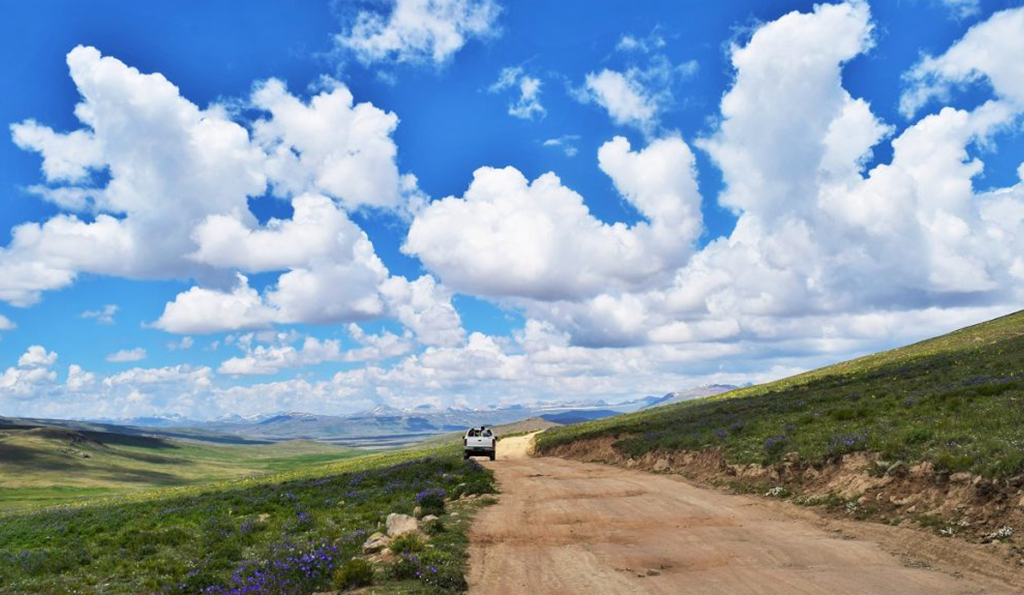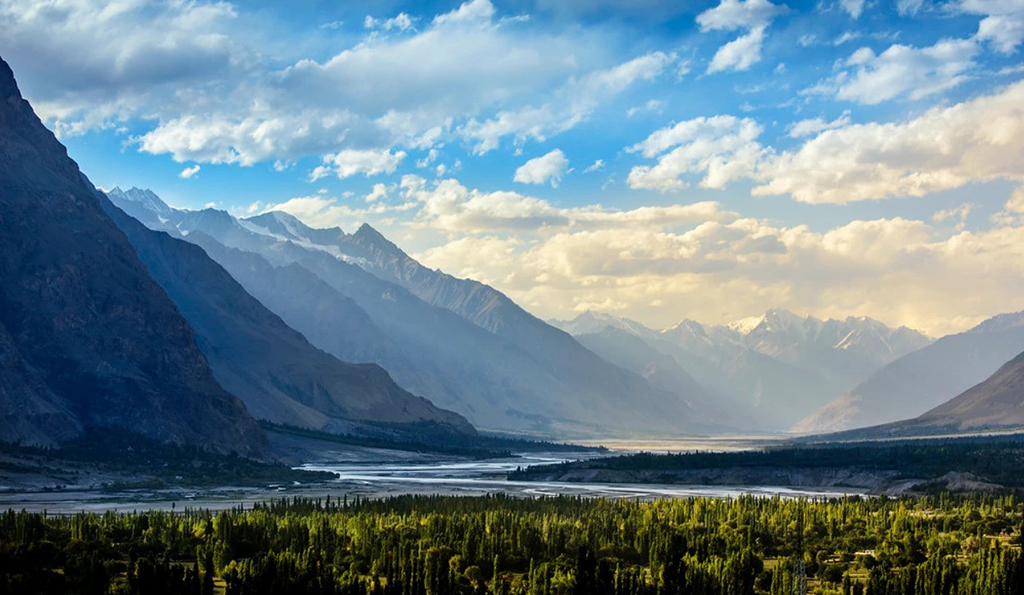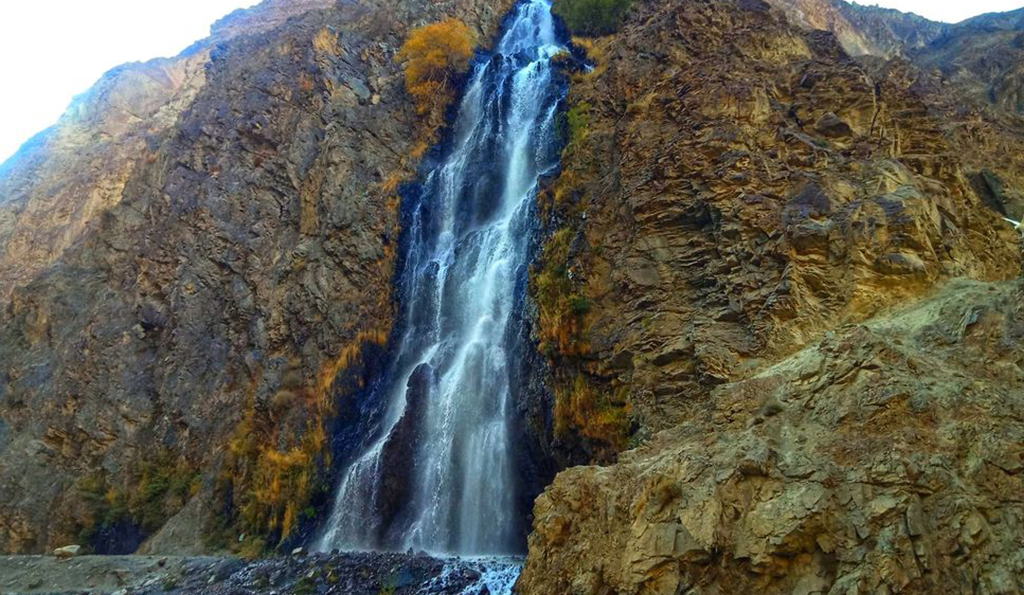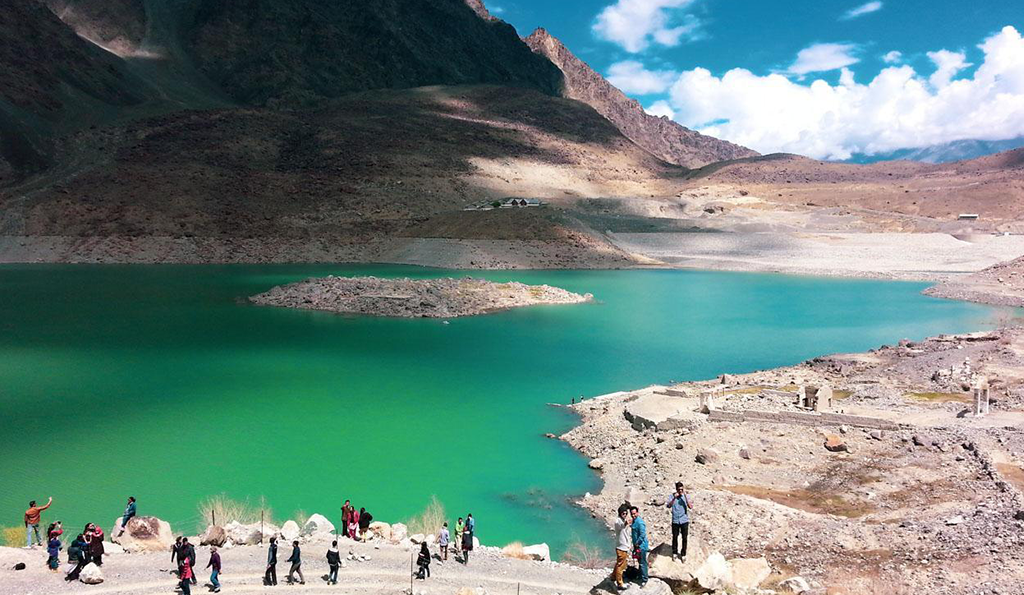Skardu, located in the Gilgit-Baltistan region of Pakistan, is a picturesque and captivating destination. Nestled amidst the towering peaks of the Karakoram Range, Skardu offers breathtaking landscapes, serene lakes, and a rich cultural heritage. The town serves as a gateway to some of the world’s highest mountains, including K2. Visitors can explore Shangrila Resort, known as “Heaven on Earth,” and take boat rides on the pristine Upper Kachura Lake. Additionally, the ancient Skardu Fort, perched on a hilltop, provides panoramic views of the surrounding valleys. Adventure enthusiasts can embark on treks to nearby glaciers, such as Baltoro Glacier and Concordia. Skardu’s unique blend of natural beauty and historical significance makes it an unforgettable destination for travelers seeking both tranquility and adventure.
Places of Attractions
Shangrila Resort

Shangrila Resort, also known as “Heaven on Earth,” is nestled amidst some of the world’s highest peaks in Skardu, Pakistan. Encircling the heart-shaped Kachura Lake, the resort offers awe-inspiring views of fruit-laden orchards and flower-filled gardens. Founded in 1983, it was the first-ever resort established in the Northern Areas for tourism. The serene and scenic ambiance, combined with stunning beauty, makes it a tranquil retreat for travelers seeking natural splendor and relaxation. The resort features elegantly furnished cottages and VIP suites, each providing an awe-inspiring lakeside view. Visitors can enjoy exquisite cuisine at the “Pagoda” restaurant, explore nearby attractions, and experience the breathtaking panorama of the awe-inspiring mountains from the View Point. Shangrila Resort Hotel Skardu truly lives up to its name as a slice of paradise in the Karakoram Range.
Deosai National Park

Deosai National Park is an alpine plateau of exceptional beauty and ecological value, situated in the western massif of the Himalayas. It lies east of Nanga Parbat Peak and in close proximity to the Central Karakoram Range. This high-altitude national park spans an area of 843 square kilometers (325 square miles) and boasts an average elevation of 4,114 meters (13,497 feet) above sea level. The Deosai Plains, often referred to as the “Land of Giants,” are home to diverse flora, including wildflowers, and serve as a critical habitat for the critically endangered Himalayan brown bear (Ursus arctos isabellinus). In spring, the plains come alive with vibrant blooms and fluttering butterflies, making it a captivating destination for nature enthusiasts and wildlife lovers.
Kachura Lakes

The Kachura Lakes, consisting of Upper Kachura Lake and Lower Kachura Lake, are serene alpine lakes located near Skardu. The Upper Kachura Lake, also known as Shangrila, is renowned for its crystal-clear waters and picturesque surroundings, including lush green meadows and towering peaks. The Lower Kachura Lake is equally enchanting, with its tranquil setting and vibrant flora. Both lakes are perfect for leisurely boat rides, picnicking, and enjoying the natural beauty of the region. The Kachura Lakes provide a peaceful retreat and stunning scenery that captivates visitors seeking solace in nature.
Sadpara Lake

Sadpara Lake, also known as Satpara Lake, is a natural gem nestled near Skardu in the Gilgit-Baltistan region of Pakistan. Fed by the melting ice of the Deosai Plains, this freshwater lake serves as a vital water source for the Skardu Valley. At an elevation of 2,636 meters (8,650 feet) above sea level, Sadpara Lake spans an area of 2.5 square kilometers. Its turquoise waters reflect the surrounding snow-capped peaks, creating a serene and captivating landscape. Currently, a dam is under construction, which will enhance the lake’s water capacity while preserving its breathtaking beauty.
Manthokha Waterfall

Manthokha Waterfall, also known as Mantoka Waterfall, is a stunning natural wonder located in the Kharmang Valley near Skardu, Gilgit-Baltistan, in the extreme northern region of Pakistan. This majestic waterfall stands approximately 180 feet high and is situated about 80 kilometers (50 miles) away from downtown Skardu. Nestled amid the towering rocky mountains of the Karakoram, the waterfall cascades down into green pastures, creating a picturesque setting for visitors. The nearby restaurant offers local trout fish, and sightseers can explore the fish farm while enjoying the breathtaking views. Manthokha Waterfall is a hidden gem accessible via a challenging hiking trail, making it a rewarding adventure for those who seek its beauty.
Katpana Desert (Cold Desert)

The Katpana Desert, also known as the Cold Desert, is a high-altitude desert located near Skardu in District Shigar, Gilgit-Baltistan, Pakistan. This unique desert features large sand dunes that are occasionally covered in snow during the winter months. Situated at an elevation of 2,226 meters (7,303 feet) above sea level, the Katpana Cold Desert ranks among the highest deserts globally. While it technically stretches from the banks of the Indus River south of Skardu to New Ranga Village in the north, the portion most frequented by tourists lies near Katpana Lake, close to Skardu Airport.
Shigar Fort

Shigar Fort, also known as the “Old Fort,” is a beautifully preserved historical monument located in the Shigar Valley. This fort, dating back to the 17th century, showcases traditional Balti architecture with its intricately carved wooden balconies and vibrant frescoes. The fort has been meticulously restored and converted into a museum and guesthouse, allowing visitors to experience the elegance of its historic design and explore exhibits that highlight the region’s cultural heritage. The fort’s tranquil garden and serene surroundings make it a peaceful retreat with stunning views of the valley and the nearby mountains.
Khorpocho Fort

Khorpocho Fort, also known as Skardu Fort, stands as an ancient architectural marvel in the Skardu Valley of Gilgit-Baltistan, Pakistan. Perched atop a mountain, approximately 40 meters above the town, this historic fortress offers panoramic views of Skardu and the surrounding landscape. Built in the 16th century by King Ali Sher Khan, it served as a military stronghold to protect the town from invading forces. Visitors can explore its intricately carved rooms, underground tunnels, and a small museum showcasing artifacts related to Skardu’s rich cultural heritage. To reach the fort’s summit, a one-hour trek from Qatilgah Main Bazar in Skardu is required. Additionally, nestled behind Khorpocho Fort on the banks of the Indus River lies Nansoq Village, an organic settlement known for its clear climate and vegetation, just 16 kilometers from Skardu. The Aga Khan Rural Support Program supported the creation of this unique village.
Soq Valley

Soq Valley, located near Skardu in Gilgit-Baltistan, Pakistan, is a hidden gem waiting to be explored. Situated at an elevation of 2,500 meters, it offers breathtaking natural beauty. Soq Valley lies in the upper part of Kachura, just 23.4 kilometers away from Skardu. You can reach it within half an hour from Shangri-La Resort, making the journey engaging and worthwhile. To reach Soq Valley, you’ll need a 4×4 vehicle or a jeep. The rugged terrain adds to its charm, and although SCOM signals are limited, the enchanting beauty remains unaffected. Soq Valley boasts lush green meadows, crystal-clear streams, and pristine lakes. It’s home to the rich flora of the western Himalayan conifer forests, with wild apricot orchards adding to its allure. Every visit offers a new life experience. Trekking is a favorite activity here. Adventurous souls can trek from Kachura village to reach Soq Valley. Unwind, explore, and immerse yourself in nature’s splendor.
Khaplu Valley

Khaplu Valley, also known as “Shyok Valley” and “Little Tibet,” serves as the administrative capital of Ghanche district in Gilgit-Baltistan, Pakistan. Located approximately 112 kilometers east of Skardu, this scenic valley sprawls along the River Shyok, a tributary of the River Indus. It lies next to the ancient trade route to Ladakh, making it historically significant. Khaplu is a base for treks to peaks like Mashebrum, Gondogoro, Chogolisa, K-6, and K-7. The valley’s architectural heritage includes the Chaqchan Mosque, one of the oldest and largest mosques in the region, built around 700 years ago. Additionally, the Khaplu Palace (locally known as “Yabgo Khar”) is a major tourist attraction, offering a glimpse into the region’s rich history and culture.
Skardu Fort

Skardu Fort, also known as Kharpocho Fort, stands majestically overlooking the Skardu Valley, offering a glimpse into the region’s rich history and strategic importance. The fort, with its imposing structure and ancient architecture, was originally built in the 8th century and has been a witness to various historical events. From the fort’s elevated position, visitors can enjoy panoramic views of the Skardu town, the Indus River, and the surrounding mountain ranges. The site provides a fascinating insight into the region’s cultural heritage and is a popular spot for photography and exploration.
Manthal Buddha Rock

The Manthal Buddha Rock is an ancient rock carving located near Skardu, featuring an impressive depiction of a seated Buddha. This historical site dates back to the 8th century and holds significant cultural and religious value. The rock carving is set against a dramatic backdrop of rugged mountains, adding to its mystique and grandeur. Visitors can explore the site to admire the intricate artwork and learn about its historical context. The serene and contemplative atmosphere of the Manthal Buddha Rock offers a unique glimpse into the region’s Buddhist heritage and artistic traditions.








